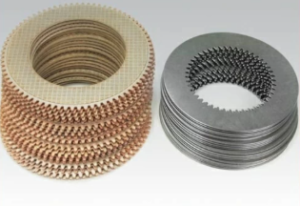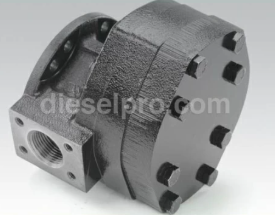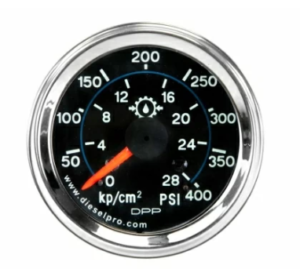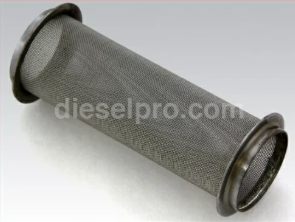
For commercial vessels running Twin Disc MG5114A marine transmissions, routine maintenance is not optional—it’s mission-critical. Whether you’re operating a tugboat in coastal waters, a commercial fishing vessel offshore, or a pilot boat in a bustling port, your transmission is under constant load, heat, and hydraulic pressure.

Parts Catalog for Twin Disc MG5114A Marine Transmissions
Plate Kit For Twin Disc MG5114A Marine Transmission
Gasket Kits For Twin Disc MG5114A Marine Transmission
Routine maintenance is the most effective way to:
- Prevent transmission failure at sea
- Avoid costly downtime and emergency towing
- Extend the useful life of your marine gear
- Catch small problems before they lead to total failure
This section outlines a comprehensive routine maintenance schedule tailored specifically to the MG5114A transmission, using real-world servicing experience from marine mechanics, fleet operators, and gear specialists. For specific torque specs, pressure ranges, and internal tolerances, please refer to the OEM Twin Disc manual.
Daily Checks

These are basic checks that should be performed before starting the engine and engaging the gear. They require no special tools and take less than 10 minutes. Performing these daily will prevent larger issues down the line.
Oil Level and Clarity
Start with checking the transmission oil level via the dipstick. The MG5114A typically features an accessible dipstick on the top or side of the gear housing.
- Ensure the oil level is within the safe operating range. Too low can cause clutch burnup; too high can cause frothing and aeration.
- Pull a sample onto a clean white cloth. Examine color and texture:
- Healthy oil is typically amber or light brown.
- Milky oil indicates water intrusion.
- Black or burnt-smelling oil signals overheating or clutch degradation.
- Metal flakes suggest internal gear or bearing wear.
Oil condition can reveal engine coupling issues, cooler leaks, or clutch pack problems before they cause failure.
Pro Tip: Replace the oil if it smells like burnt toast. That’s a clear sign of clutch friction material breakdown.
Unusual Vibrations or Noise
Start the engine with the transmission in neutral and observe it at idle and various RPMs. Then engage forward and reverse gears momentarily.
- Growling, whining, or humming noises can signal bearing failure or gear misalignment.
- Thudding or bumping on gear engagement may indicate low hydraulic pressure or warped clutch discs.
- Vibrations under load can point to:
- Misalignment between engine and gear
- Damaged mounts
- Propeller shaft issues
Never ignore new noises—marine gears don’t get quieter over time.
External Leaks and Loose Connections
Walk around the transmission and:
- Check for drips, puddles, or wet spots at the front and rear seals, side covers, and cooler line fittings.
- Wipe fittings and watch for fresh leaks under pressure.
- Check shift linkage, if mechanical, for play or misalignment.
- Inspect cooler hoses for wear, cracks, or loosened clamps.
A leak caught early is a minor repair. Left unattended, it becomes a multi-thousand-dollar rebuild or worse—failure at sea.
Weekly Maintenance

Performed every 50–100 hours of operation or weekly on commercial boats. These tasks involve monitoring operating conditions and keeping the transmission bay clean and safe.
Oil Temperature Monitoring
Transmission oil temperature should stay within normal operating limits—usually between 140°F and 190°F (60°C to 88°C). Excessive oil temperature:
- Breaks down oil viscosity
- Wears clutch packs prematurely
- Damages internal seals
If the transmission is not equipped with a temperature gauge, consider installing one or using an IR thermometer at the oil cooler return line.
Check temperature:
- After 1 hour of typical operation
- During heavy-load maneuvers
- On high-ambient temperature days
Warning: If the oil is approaching 200°F+ under normal load, inspect the oil cooler, thermostat, and fluid levels immediately.
Pressure Readings (If Applicable)
Many MG5114A installations feature a hydraulic pressure port or gauge on the control valve or test port. Check operating pressure while:
- Idling in neutral
- Engaged in forward
- Engaged in reverse under slight load
Hydraulic pressure typically ranges from 150 to 300 PSI, depending on load and configuration. Watch for:
- Low pressure: Worn pump, clogged filter, or internal leak
- High pressure: Blocked cooler return, stuck valve
If your vessel doesn’t have a pressure gauge, you can install a test port kit to use during service intervals.
Cleanliness of the Housing
Marine engine rooms are harsh environments. Dirt, salt, oil, and vibration combine to create buildup that can hide problems.
Every week:
- Wipe down the transmission housing with rags or degreaser.
- Clean around the dipstick, filter housing, and oil cooler fittings.
- Ensure there’s no insulation or debris restricting airflow around the gear.
Not only does this help detect leaks early, it also prevents corrosion and overheating from external contamination.
Monthly Maintenance
Recommended every 200–300 hours or once per calendar month in active-use vessels. These checks involve physical touchpoints that are essential for long-term integrity.
Drain Plug Check
Carefully remove the magnetic drain plug and inspect for metal accumulation. Use a clean cloth or glove:
- A small amount of fine dust is normal.
- Large flakes, shards, or slivers are not—and suggest gear tooth, clutch disc, or bearing damage.
- If there is grey sludge, your oil may be emulsifying due to water ingress.
Replace the plug with thread sealant and recheck tightness after warming the gear up again.
Vent Filter Inspection
The MG5114A is vented to prevent pressure buildup. Some models use a breather cap, others use a vented plug.
Once per month:
- Clean or replace the breather element.
- Ensure the vent isn’t clogged with salt, soot, or sludge.
- A clogged vent can create pressure buildup, leading to blown seals or housing cracks.
If you find oil weeping out of the dipstick or breather, it may be a sign of internal pressure problems.
Mounting Bolts Torque Check
The MG5114A is subjected to:
- Torsional stress from the engine
- Vibration from the hull
- Shaft load from the propeller
All of this means that even properly torqued fasteners can loosen over time.
Once per month:
- Check engine coupling bolts
- Inspect gear mounting feet and cradle bolts
- Torque to manufacturer spec using a calibrated torque wrench
Never reuse corroded bolts, and use anti-seize or marine-rated thread locker where recommended.
Annual or Hour-Based Intervals

This is where you go beyond surface-level maintenance and ensure the long-term mechanical health of your MG5114A. These procedures should be logged and scheduled into your fleet’s maintenance calendar.
Full Oil Change Intervals
While oil top-offs and visual checks are important, only a full change removes acids, soot, and microscopic metal.
Recommended interval:
- Every 1,000 hours of operation, or
- Annually, whichever comes first
Steps:
- Warm the engine to operating temp
- Shut down and drain oil fully using suction or gravity
- Replace filter
- Refill using OEM-spec hydraulic oil (usually SAE 30 or SAE 40 depending on temp)
Always check for proper oil type compatibility. Improper fluid leads to clutch slip and bearing starvation.
Oil Filter Change
The MG5114A uses either an internal cartridge filter or an external spin-on filter depending on the version. These filters:
- Catch metal shavings
- Trap varnish from overheated oil
- Extend pump and clutch life
Annual filter service includes:
- Removing and inspecting the old filter
- Checking for metal or burnt smell
- Installing a new filter with clean threads and new O-ring
- Priming the oil circuit, if needed
Never reuse filters. Cheap filters are a leading cause of pressure drops and internal scoring.
Gear Backlash and Wear Pattern Inspection
If you’re hauling out the vessel or performing major maintenance, now is the time to inspect the internal gearset.
Check for:
- Excessive backlash (too much play between gears)
- Pitting or scoring on gear teeth
- Uneven wear indicating misalignment or overload
- Signs of fretting corrosion or oil starvation inside housing
While checking backlash requires partial disassembly, it’s essential after:
- Thousands of hours
- Overload incidents
- Propeller strikes
- Any hard clutch engagement failures
Document findings and consider a rebuild or parts replacement if you find significant wear.
Summary Maintenance Schedule Table
| Interval | Tasks |
| Daily | Check oil level & clarity, inspect for leaks, listen for noise/vibes |
| Weekly | Monitor oil temperature, check pressure (if equipped), clean housing |
| Monthly | Inspect drain plug, clean vent filter, torque mount bolts |
| Annual / 1000 hrs | Full oil change, oil filter change, gear inspection |
Final Thoughts on Preventive Maintenance
The MG5114A is engineered for long life, but like any marine system, it thrives with attention. Routine maintenance is your best defense against failure, and it’s often more affordable than waiting for symptoms to emerge.
- Log all service intervals in your maintenance system
- Train your crew to detect signs of trouble
- Use only high-quality aftermarket parts from trusted suppliers
- Schedule a full inspection during haul-outs, engine overhauls, or major upgrades
By following the maintenance intervals outlined here, you’ll extend the life of your transmission, improve vessel safety, and keep your operation on schedule and on budget.

Plate Kit For Twin Disc MG5114A Marine Transmission
Gasket Kits For Twin Disc MG5114A Marine Transmission
Videos About Twin Disc Transmissions
6 Reasons Your Twin Disc Transmission Has Low Oil Pressure
7 Reasons Your Twin Disc Transmission Is Overheating
3 Reasons Your Clutch Plates in Your Twin Disc Transmission Are Making Excessive Noise
Bull Gear On A Twin Disc Transmission
Rebuilt Twin Disc Transmissions



 Free US Calls: 1-888-433-4735
Free US Calls: 1-888-433-4735 International: 305-545-5588
International: 305-545-5588